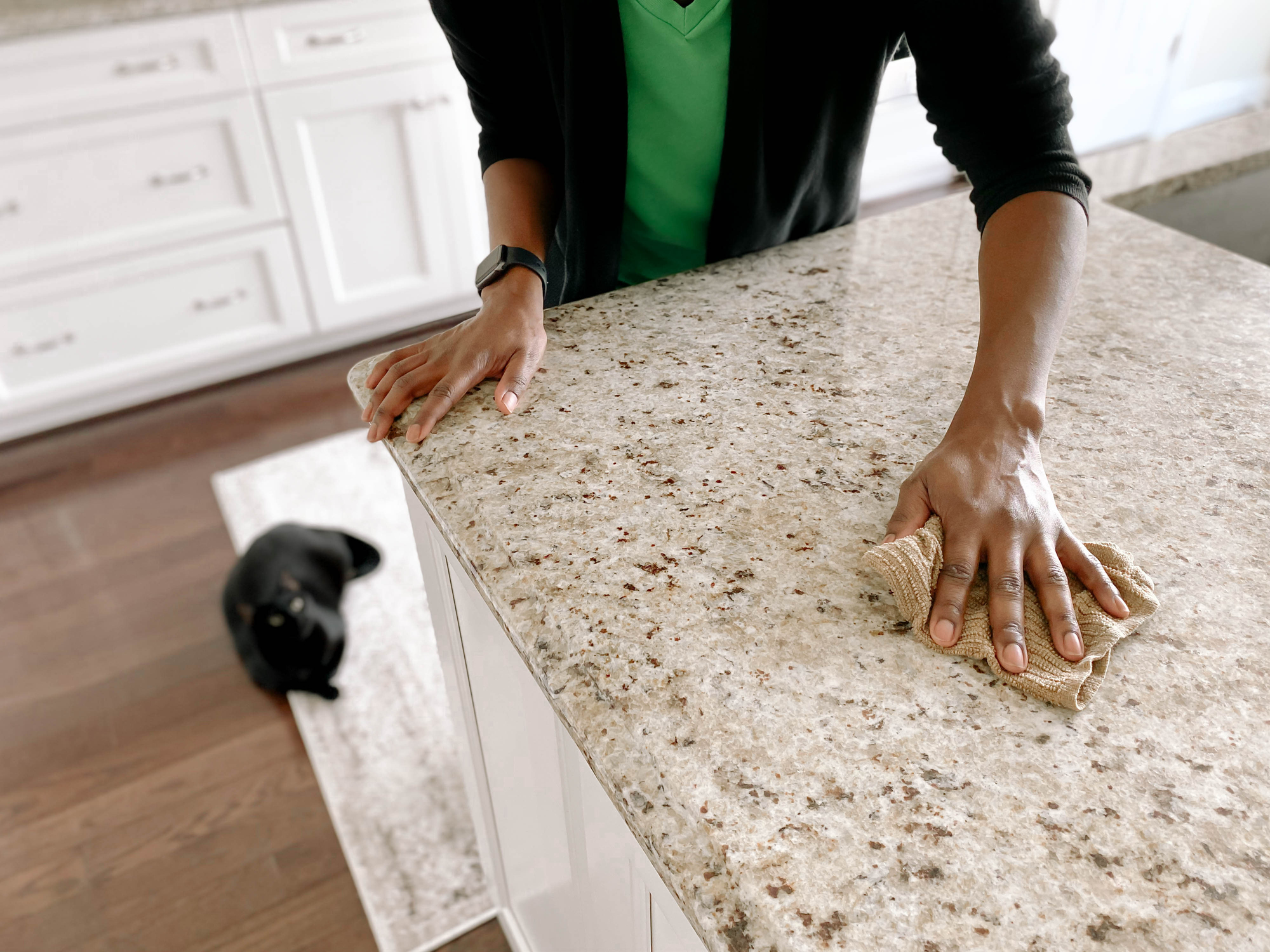How to seal a granite countertop
Preserve your investment with proper daily care and the right products for cleaning, sealing, and polishing your granite countertop or other natural stone.


You’ve taken the plunge and updated your kitchen. The new cabinets with granite countertop not only bring your home into the 21st Century but look fantastic too. The National Association of Realtors’ 2019 Remodeling Impact Report gives a kitchen upgrade a Joy Score of 9.7 and you couldn’t agree more. After all, the heart of your home is beating stronger than it ever has and you find your family congregating there even more.
However, granite’s not cheap. With prices ranging from $40-75 per square foot, according to The Home Depot, you want to protect your investment to keep those countertops sparkling for years to come. That’s why preserving the seal on your granite is so important. But before you slather anything on this precious stone, let’s look at how to seal a granite countertop the right way (it's a good idea to learn how to polish countertops, too).
Do granite countertops need to be sealed?
By nature, granite is a porous material. Unsealed, it will soak up spills and moisture from food residue, oil from the bottom of your salad dressing bottle, or condensation from your iced drink. But that doesn’t mean you have to seal your countertop, yet. Because many natural stone products come with a factory seal on them.
If you’re unsure if your countertop came sealed, or if it’s been a few years since you installed it, you can easily test the seal on your granite.
- Have a few different types of counters in your kitchen? See also: How to seal butcher block
How to test the seal on a granite countertop
Applying sealant to a countertop unnecessarily will do nothing and, if you don’t buff it all off, it will leave a film on the surface. So, to save yourself a little frustration and the money spent on an expensive product, test your granite's seal with this simple method.
- In an inconspicuous location, drizzle a small amount of water in one spot and a little oil in another spot.
- Let the liquids sit for 15-30 minutes.
- Check to see if the granite has absorbed any of the liquids or if they’ve darkened the stone underneath.
- If you see less liquid or a dark discoloration of the stone, you need to apply a granite sealer.
How to seal a granite countertop
Before sealing, remove everything from the counters and thoroughly clean the countertops with a hot soapy cloth to remove dust, crumbs, and food residue. Once cleaned and dry, apply a granite sealer as follows:
- Spray a 3-foot section of the countertop with the sealer.
- Immediately wipe the product into the stone with a soft, lint-free cloth. Allowing it to dry will create a dull haze.
- Buff the surface until dry with a dry lint-free cloth.
- Repeat the process two to three times.
- Keep the surface dry for 24 hours before polishing to allow the product to cure and bond to the pores.
To help your granite keep its natural shine, follow the sealer with a granite polish. Apply it the same way you applied the sealer. Spray on, immediately buff with a lint-free cloth, and wipe dry.
Get small space home decor ideas, celeb inspiration, DIY tips and more, straight to your inbox!
How to remove existing stains on granite
If your granite has a stain, you’ll need to remove it before resealing. To remove a stain from your granite countertop, use a limestone poultice product per the label directions between the deep clean and the sealing stage.
How often do you need to reseal granite countertops?
That depends on the product, whether it came factory-sealed, and how you care for it every day. If your countertop came factory-sealed, its seal could last 10 to 15 years. But if it isn’t, or if you have an older countertop, you will need to reseal it every six months to a year.
Daily care for granite countertops
Proper daily care will preserve the seal on your granite. Here are a few ways to keep it sparkling:
- Only use pH-neutral products manufactured specifically for stone care.
- Always use a soft cloth or sponge on your countertop to avoid abrasions.
- Avoid opening chemicals like bleach, drain opener, or other household cleaners on your countertop.
- Immediately clean up all spills, including water.
- Use coasters, placemats, trivets, and cutting boards to protect the surface.
- Avoid chips or cracks by not dropping heavy objects on it.
- Don’t sit or stand on your granite.
- Avoid using high-temperature appliances, like a toaster oven, deep fryer, or rotisserie, as the high heat and grease splatters could damage the stone.
Granite sealers to choose from
Since granite is a porous material, avoid acidic and abrasive cleaners. Mild soap and water for daily cleaning is best. Powdered cleansers often contain pulverized stone that can scratch the surface. Also, the acidic content of citrus-based products, ammonia, or homemade cleaners that contain vinegar or lemon oil, can dull the finish. If you want to purchase made-for-granite cleaners and sealers, here are a few to choose from.
Carol J. Alexander writes website copy, blog posts, and feature articles on home remodeling and construction topics from her home in the Shenandoah Valley of Virginia. In addition to Real Homes, notable clients include, This Old House, Family Handyman, and Florida Roofing magazine.
